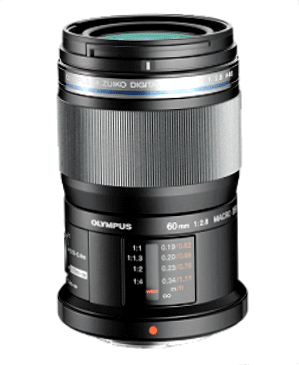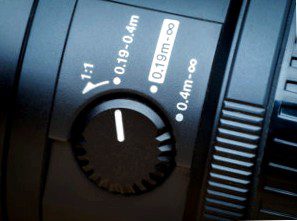

The M.Zuiko Digital ED 60mm f/2.8 is the standard macro lens from OM System (formerly Olympus) and thus logically the first choice for OM’s Micro-four-thirds (MFT) system since its launch in 2012.
But is the lens really the best macro for MFT??
Where does the M.Zuiko 60mm stand out from the competition and what are its strengths and special features?
Note – non-technical review:
In my tests and reviews, I focus on my individual approach to macro photography (extreme close-up, live subjects, esp. smallest spiders and insects) – this should always be kept in mind regarding all my subjective opinions and evaluations.
For example, if a lens isn’t right for my personal photography style, that doesn’t mean it may well not be just right for your workflow – and vice versa.
The lens and scope of delivery

Despite the high plastic content, the slim lens feels valuable and is perfectly finished.
In a cool environment, it does not take on the low temperatures too quickly, as would be the case with a lens with a metal body.
The absence of a metal jacket makes for an extremely light weight of only 185 grams – in the field, on photo tour, another plus point.
At the same time the M.Zuiko 60mm, as one of very few macro lenses for micro-four-thirds, splash-proof.
The lens has 7 diaphragm blades and can be stopped down to a max aperture of 22. Aperture of 22.
In the macro range, esp. Direction of the upper magnifications, but should be well below this max. Aperture stay.
The magnification of the lens extends up to a reproduction scale of 1:1.
The sog. Sweet spot of the M.Zuiko 60mm macro is at f/5.6.
Sharpness decreases noticeably as the aperture is closed further, and diffraction blur becomes (esp. above f/11) is very obvious.
With a distance scale, a focus limiter switch and an electronically translated, smooth-running focus ring, the lens is almost luxuriously equipped.
Included in delivery are front and rear covers, as well as the user manual.
A switch to change from manual to autofocus, as well as a lens hood are unfortunately missing here.
The LH-49 sliding lens hood
With the LH-49, the M.Zuiko 60mm an innovative as well as ingenious lens hood, available separately.
This is not, as usual, turned upside down at the front of the lens when not in use, but can, as the name suggests, be slid back and forth.
All important controls of the lens remain accessible.

Pros and cons M.Zuiko 60mm
Per
- Top sharpness
- Compatible with all OM System camera software features
- Light& compact
- Autofocus
- Focus limiting switch and 1:1 shortcut
- Dust and water resistant
- Internal focusing
Contra
- “only” 1:1 reproduction ratio
- Larger plastic part of the housing
- No built-in image stabilizer
- No lens hood included
Photographing with the M.Zuiko 60mm macro
The M.Zuiko 60mm Macro fits perfectly into the handy OM System MFT setups with its compact dimensions, even if it seems a bit “long”.
It is easy to adjust, all important elements are optimally arranged and quickly accessible.
The closest focusing distance of 19cm (subject to sensor distance) is in a comfortable middle range for macro photography.
Even shy jumping spiders or insects can be photographed at close range with a little practice and experience (and flash with diffuser) – even at a reproduction scale of 1:1.
Here you have to reach the subject up to 8.5cm (measured from the front lens).
The bokeh is soft and pleasant.

At first, the focus limiter may take some getting used to, but it is also a shortcut for directly setting the 1:1 magnification, thus eliminating the need to turn the focus ring.
Adjustable focus areas are 0.4 m to infinity, 0.19 m to infinity, 0.19 m to 0.4 m as well as 1:1.
By the way, there is a practical function in the OM System camera settings that ensures that the camera remembers the last magnification set, even if it is switched off.
With the OM-D E-M1 III for example, this is the option “Reset lens” in the menu item A4.
More tips& Tricks around the M.By the way, you can find Zuiko 60mm here again explicitly (post in English, link follows).

Since I shoot almost exclusively with high image scales, my setup is preset and I rarely change the settings.
I operate the lens in manual mode and then focus by moving my whole setup back and forth.
Depending on the motif, then perhaps change the aperture setting now and then – nothing more.
Negative aspects have come to my attention in this workflow with the M.Zuiko 60mm none noticed so far.
It otherwise does what it’s supposed to; produces sharp photos, is lightweight and compatible with the versch. Camera macro modes compatible – what more could you ask for?
With its maximum magnification of 1:1, the M.Zuiko 60mm a great flexibility for a wide variety of image effects.
There really is a world of difference between 1:4 and 1:1, as the sample photos here show.


Example photos








Conclusion
In conjunction with the use of OM System in-camera focus bracketing and focus stacking leads at the M.Zuiko 60mm macro no way around!
Although there are a few lenses from other manufacturers that offer even greater magnification, these are all manual lenses that are not compatible with the o.g. Functions compatible are.
In fact, the reproduction scale of 1:1 is absolutely sufficient for most areas of macro photography and enables detailed and crisp close-ups.
Only with very small motifs or. In the area of extreme macros, the M.Zuiko 60mm then at some point to its limits.
However, even here, e.g. Using close-up lenses, such as those from NiSi or the Raynox DCR250, even larger imaging scales are possible – and without losing the power of focus bracketing and stacking.
An absolute plus in direct comparison to manual lenses without contacts.
Until the release of the M.Zuiko 90mm f/3.5 IS Pro from OM Systems current roadmap is and remains the M.Zuiko 60mm macro one of my absolute favorite lenses.